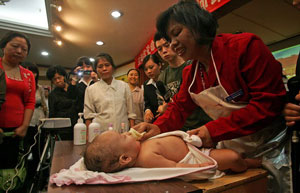World Business
US Fed's new relaxed monetary policy triggers controversy
(Xinhua)
Updated: 2010-11-08 17:32
 |
Large Medium Small |
WASHINGTON - US Federal Reserve announced?on Nov 3?it will buy $600 billion more in Treasury bonds, known as the "Quantitative Easing" (QE2) monetary policy to boost the sluggish economic growth. This move has been drawing wide concerns and criticism.
REASONS FOR THE POLICY
"The pace of recovery in output and employment continues to be slow," the Fed said in a statement after a policymaking panel meeting on Nov 3.
Federal Open Market Committee (FOMC), the interest rate policy making body of the central bank said that it will "purchase a further $600 of longer-term Treasury securities by the end of the second quarter of 2011, a pace of about $75 billion per month."
"Household spending is increasing gradually, but remains constrained by high unemployment, modest income growth, lower housing wealth, and tight credit. Business spending on equipment and software is rising, though less rapidly than earlier in the year, while investment in nonresidential structures continues to be weak," the Fed said.
It noted that employers remain reluctant to add to payrolls and housing starts continue to be depressed. Longer-term inflation expectations have remained stable, but measures of underlying inflation have trended lower in recent quarters.
Bernanke and his supporters argue that the Fed is failing in both fronts of its dual mandate: sustainable levels of unemployment and inflation.
Latest data showed that core consumer price index, the key figure to measure inflation, grew only 0.8 percent in September on a yearly base.
It was lower than the Fed's comfortable level of inflation ranging from 1.5 percent to 2.0 percent.
In fact, the Fed expressed its concern about deflation in recent documents.
On the unemployment front, with 14.8 million Americans unemployed and unemployment rate hovering at double digit, the Fed has been facing criticism. The Fed said that to expand its holding of government securities is "to promote a stronger pace of economic recovery and to help ensure that inflation, over time, is at levels consistent with its mandate."
Statement released on Wednesday also showed that The Fed decided to maintain the target range for the federal funds rate at historic low level of zero to 0.25 percent to boost the economic recovery.
CONTROVERSY AND UNCERTAINTY
The QE2 has triggered global debate and many economists believe that the policy's effectiveness is uncertain.
Bernanke's supporters argue that it is within the Fed's responsibility to push the economic growth and there is no other tools in the Fed's tool box.
The central bank cut the interest rate to the current level in December 2008 to tackle the worst recession after the Great Depression in the 1930s.
And it has already bought about $1.7 trillion in US government debt and mortgage-linked bonds.
Bernanke's bold action to gamble on the QE2 policy has drawn not only critics outside the central bank, but also aroused inner opponents.
Kansas City Fed President Thomas Hoenig, who is concerned the Fed's easy money policies are prelude to yet another boom and bust cycle, said on Oct 25 that further easing would be "a bargain ... with the devil."
Some economists, and some Fed policymakers, also worry further purchases could jeopardize the central bank's credibility if the impact proves small.
In addition, there are concerns the Fed's bloated balance sheet may set the stage for rampant inflation once the recovery gains traction.
Many economists doubt about the policy's effectiveness and worry about its spillover effect on the rest of the world.
"Although the US economy is weak and the outlook uncertain, QE is not the right remedy," said the former president of the US National Bureau of Economic Research and former chief economic adviser to President Ronald Reagan.
The US economy grew at a 2.0 percent annual rate in the third quarter 2010, slightly more than a 1.7 percent expansion in the second quarter.
Economists consider that economic growth must reach about three percent for some time to significantly reduce high unemployment. But more than a year after the recession officially ended, unemployment stubbornly stands at high level. Economists expect that October's jobless rate, which will be reported on Nov 5, will remain at 9.6 percent for the third straight month.




